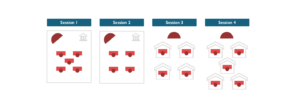Timetable Absurdity
Key Points
-
In a century that is being defined by flexibility in time, we no longer need to be held hostage by sacred school timetables.
-
If we value deep learning and human connection, then this should be explicitly built into the school schedule.

“Every weekday I walk into my first class period exhausted from the previous night’s homework. For 55 minutes my teacher teaches, I take notes, and then the bell rings. I scribble down my homework, get up, and repeat. Seven times. Five days a week for the past six school years.”
Imagine if you had to move to a different office and focus on a new problem every hour, sitting down for the entire time, with repetitive work to do after hours, and to top it off, the managers who supervise your various commitments don’t communicate with each other. This is the daily experience for high school students, and teachers are just as restricted: 25 new people enter the classroom every hour, meetings usurp preparation, and unfinished planning follows them home. Nobody benefits from the frenetic pace.
Time is the most controlling structure and the scarcest commodity in schools, and the traditional school schedule is the greatest impediment to educational innovation. Any attempt to redesign the schedule runs up against the intricate constraints of parental custodial expectations, teacher comfort in the known, part-time staff, curriculum mandates, bus schedules, sports schedules, objections from unions, and high-stakes tests. Teachers are held hostage by the sacred timetable, warned that one small change will cause a disastrous cascade.
While flexibility in time and space will define the workplace in this century, students get little experience deciding how to learn, where to learn, and when to learn, because schools account for every minute. Schooling is predicated on the perception that busyness is good. Treadmill schedules leave little time for deep learning, quietude, or human connections.
- What does our allocation of time say about what we value in the teaching and learning process?
- How can we provide time to enable young people to take more personal responsibility for their own learning, in line with the adolescent predisposition to begin taking charge of their lives?
- If flexibility in time and space will define living and working this century, how can school best prepare young people for this?
Stephen Covey wrote about Big Rocks, the things we value and feel are truly important. Big rocks are our priorities, the things we want to make room for. If school schedules reflect values and priorities, then we currently value speed, uniformity, and quantity over depth, individuality, and quality.
In Finland, students only spend about five hours a day in classrooms and they have little to no homework. The rule of thumb is 15 minutes of recess per hour of work. Deeper learning advocates recommend daily schedules where students study three or four subjects for around 90 minutes at a time, rather than the usual six 50-minute blocks. Steiner’s model of a deep learning period, where students focus on a single subject for at least two hours, is another way of shaking up the traditional school day. However, there is no optimal class length. The best length of a class period will be different depending on the age of the students, the culture, the number of students, and the experience of the teacher. How teachers use the time they are allocated is more important than the length of the lesson. It is not about how long we teach for but how well we teach with the time we have.
In a century that is being defined by flexibility in time, we no longer need to be held hostage by sacred school timetables.
Cameron Paterson
Australian teachers are doing more face-to-face teaching than the OECD average, yet Australia’s performance in PISA has been steadily declining. Countries with higher-performing students give teachers more planning time. Teachers in Shanghai have much more planning time than Australian and US teachers. Planning and collaboration time is critical to teacher job satisfaction and we should make it a priority, a big rock that we put in first.
Some students (and teachers) discovered a new sense of autonomy and flexibility during Covid-imposed remote learning, relishing the loss of early start times and being able to choose when to eat or move instead of responding to bells. Shifts in thinking about time ground evolving educational practices like flipped classrooms, blended learning, and block scheduling. In Australia, Simon Beaumont leads a school which uses a self-directed learning model that needs less face to face class time and builds independent learning habits. Andrew Beitsch wonders, “if we could start the concept of the ‘senior study period’ earlier in secondary schooling as a first step and maybe provide some space for educators to collaborate at the same time?”
At St Luke’s Catholic College high school students can opt for a supervised study session at 8:30 am three mornings a week, or they can sleep in and start at 10 am – a decision guided by research into sleep and teenage brains. Sir Joseph Banks High restructured timetables to allow senior students half days. Trinity Grammar School has a fortnightly lesson-free ay for Grade 12. At Element College, families are able to choose when they take their 12 weeks of holidays per year, without any disruption to their child’s learning or anyone else’s learning.
In a century that is being defined by flexibility in time, we no longer need to be held hostage by sacred school timetables. If we value deep learning and human connection, then this should be explicitly built into the school schedule. Cutting back on sitting, listening, and repetition, will result in more engaged, thoughtful, and creative learners.
This post is part of our New Pathways campaign sponsored by ASA, Stand Together and the Walton Family Foundation.







0 Comments
Leave a Comment
Your email address will not be published. All fields are required.